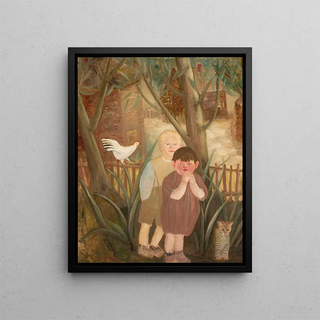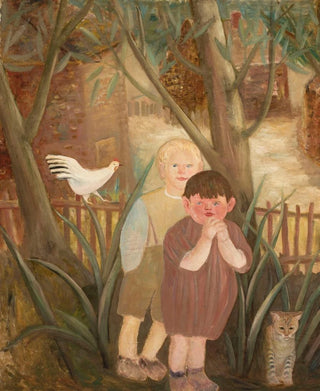Art print | Two children with a cat - Tadeusz Makowski


View from behind

Frame (optional)
In the vast panorama of art history, certain works manage to capture the essence of innocence and tenderness with such delicacy that they resonate deeply within us. "Two children with a cat - Tadeusz Makowski" is one of those creations that, through its apparent simplicity, evokes complex and universal emotions. By immersing oneself in this piece, the viewer is instantly transported into a childhood universe, where curiosity and joie de vivre intertwine in a moment frozen in time. The delicately painted scene invites contemplation, revealing a world where children's innocence blends with the gentle presence of a pet, symbolizing complicity and tenderness.
Style and uniqueness of the work
Tadeusz Makowski's style is a harmonious blend of naivety and sophistication. In "Two children with a cat," the artist manages to create a warm and welcoming atmosphere, where each element is carefully arranged to tell a story. The pastel colors, soft and soothing, envelop the scene in an almost ethereal light, while the rounded shapes and simple features of the characters evoke a childlike aesthetic. This stylistic approach, imbued with poetry, gives the artwork a timeless dimension, allowing everyone to project themselves into it and find a personal echo. The depiction of children, with their innocent expressions and delicate gestures, demonstrates mastery of child psychology, making the scene all the more touching.
The artist and his influence
Tadeusz Makowski, a Polish artist active in the early 20th century, left his mark on his era with a unique artistic vision that combines influences of cubism and impressionism. His career, though relatively short, was rich in visual and emotional explorations. Makowski was particularly fascinated by childhood, a recurring theme in his work, and he knew how to treat it with rare sensitivity. Drawing inspiration from everyday life, he succeeded in immortalizing moments of purity and simplicity, making him a pioneer in the representation of childhood in modern art. His influence

Matte finish

View from behind

Frame (optional)
In the vast panorama of art history, certain works manage to capture the essence of innocence and tenderness with such delicacy that they resonate deeply within us. "Two children with a cat - Tadeusz Makowski" is one of those creations that, through its apparent simplicity, evokes complex and universal emotions. By immersing oneself in this piece, the viewer is instantly transported into a childhood universe, where curiosity and joie de vivre intertwine in a moment frozen in time. The delicately painted scene invites contemplation, revealing a world where children's innocence blends with the gentle presence of a pet, symbolizing complicity and tenderness.
Style and uniqueness of the work
Tadeusz Makowski's style is a harmonious blend of naivety and sophistication. In "Two children with a cat," the artist manages to create a warm and welcoming atmosphere, where each element is carefully arranged to tell a story. The pastel colors, soft and soothing, envelop the scene in an almost ethereal light, while the rounded shapes and simple features of the characters evoke a childlike aesthetic. This stylistic approach, imbued with poetry, gives the artwork a timeless dimension, allowing everyone to project themselves into it and find a personal echo. The depiction of children, with their innocent expressions and delicate gestures, demonstrates mastery of child psychology, making the scene all the more touching.
The artist and his influence
Tadeusz Makowski, a Polish artist active in the early 20th century, left his mark on his era with a unique artistic vision that combines influences of cubism and impressionism. His career, though relatively short, was rich in visual and emotional explorations. Makowski was particularly fascinated by childhood, a recurring theme in his work, and he knew how to treat it with rare sensitivity. Drawing inspiration from everyday life, he succeeded in immortalizing moments of purity and simplicity, making him a pioneer in the representation of childhood in modern art. His influence






